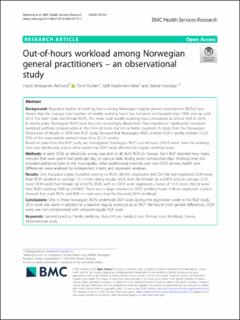| dc.contributor.author | Rebnord, Ingrid Keilegavlen | |
| dc.contributor.author | Morken, Tone | |
| dc.contributor.author | Maartmann-Moe, Kjell | |
| dc.contributor.author | Hunskår, Steinar | |
| dc.date.accessioned | 2021-05-31T10:45:27Z | |
| dc.date.available | 2021-05-31T10:45:27Z | |
| dc.date.created | 2020-12-16T08:54:15Z | |
| dc.date.issued | 2020 | |
| dc.Published | BMC Health Services Research. 2020, . | |
| dc.identifier.issn | 1472-6963 | |
| dc.identifier.uri | https://hdl.handle.net/11250/2757035 | |
| dc.description.abstract | Background
Repeated studies of working hours among Norwegian regular general practitioners (RGPs) have shown that the average total number of weekly working hours has remained unchanged since 1994 and up until 2014. For both male and female RGPs, the mean total weekly working hours amounted to almost 50 h in 2014.
In recent years, Norwegian RGPs have become increasingly dissatisfied. They experience significantly increased workload without compensation in the form of more doctors or better payment. A study from the Norwegian Directorate of Health in 2018 (the RGP study) showed that Norwegian RGPs worked 55.6 h weekly (median 52.5). 25% of the respondents worked more than 62.2 h weekly.
Based on data from the RGP study we investigated Norwegian RGP’s out-of-hours (OOH) work, how the working time was distributed, and to what extent the OOH work affected the regular working hours.
Methods
In early 2018, an electronic survey was sent to all 4640 RGPs in Norway. Each RGP reported how many minutes that were spent that particular day on various tasks during seven consecutive days. Working time also included additional tasks in the municipality, other professional medical work and OOH primary health care. Differences were analysed by independent t-tests, and regression analyses.
Results
One thousand eighty hundred seventy-six RGPs (40.4%) responded, 640 (34.1%) had registered OOH work. Male RGPs worked on average 1.5 h more doing regular work than did females (p = 0.001) and on average 2.3 h more OOH work than females (p = 0.079). RGPs with no OOH work registered a mean of 1.0 h more clinical work than RGPs working OOH (p = 0.043). There was a large variation in OOH working hours. A linear regression analysis showed that male RGPs and RGPs in rural areas had the heaviest OOH workload.
Conclusions
One in three Norwegian RGPs undertook OOH work during the registration week in the RGP study. OOH work was done in addition to a sizeable regular workload as an RGP. We found small gender differences. OOH work was not compensated with reduced regular RGP work. | en_US |
| dc.language.iso | eng | en_US |
| dc.publisher | BMC | en_US |
| dc.rights | Navngivelse 4.0 Internasjonal | * |
| dc.rights.uri | http://creativecommons.org/licenses/by/4.0/deed.no | * |
| dc.title | Out-of-hours workload among Norwegian general practitioners – an observational study | en_US |
| dc.type | Journal article | en_US |
| dc.type | Peer reviewed | en_US |
| dc.description.version | publishedVersion | en_US |
| dc.rights.holder | Copyright The Author(s). 2020 | en_US |
| dc.source.articlenumber | 944 | en_US |
| cristin.ispublished | true | |
| cristin.fulltext | original | |
| cristin.qualitycode | 2 | |
| dc.identifier.doi | 10.1186/s12913-020-05773-7 | |
| dc.identifier.cristin | 1860310 | |
| dc.source.journal | BMC Health Services Research | en_US |
| dc.identifier.citation | BMC Health Services Research. 2020, 20, 944. | en_US |
| dc.source.volume | 20 | en_US |

